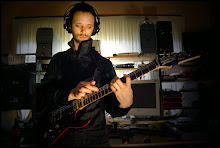Gordon Monro @ the music tech forum
16/03/2006This post is for my thoughts regarding:
Music Technology Forum 16/03/2006 at
Elder School of Music, Adelaide SA.
Guest speaker: Gordon Monro
Gordon Monro:
Gordon Monro is a Music Composer whose interest is primarily in the field of technology and its use in creating new and original sound and music.
He also happens to be a mathematician and readily applies his numerical skills to his sound design. Check out www.gommog.com for a detailed profile on the man himself.
There is something innocent and refreshing about grown, educated men who look for opportunities to incorporate Lego building into their serious day to day work. After all, as a child do you remember being less than satisfied with your creative efforts in the Lego construction department due to either your own lack of vision or your paltry collection of Lego blocks? In my case it was a combination of both. I swear I can recall a promise to myself that when I was all grown up, employed and educated that I would reignite my shattered Lego dreams with unlimited funding and brain power. It seems that Gordon Monro may have made a similar promise to himself at some point……and kept it.
I am referring of course to his experiment with two laser pointers being controlled to make random patterns by a motor and gear mechanism housed in a Lego construction. The laser pointers also send data to a voltage to midi converter which is relevant to the wanderings of each individual laser and the interaction of the two when they happen to cross paths. It makes for some interesting random sound creation. I felt there was a futuristic or ‘star wars’ type quality exuded from these sounds.
Interestingly enough, the majority of the material that Gordon played to us on the day conjured up various visual images for me that were synonymous with Star Trek / Star Wars type weaponry, vehicles and warfare. I’m curious to know if the practice of generating music and sound via predetermined mathematical calculations and programming often produces this type of end result. I don’t imagine it would be the case with ‘note generating’ algorithmic composition as this is usually associated with the algorithm determining which notes to play, but in its simplest form the notes already have a pre-determined pitch. So at its weirdest, if you were to use this method with even tempered western tuning, you may end up with a result similar to a piece of ‘serial music’ (www.sci.wsu.edu/math/Lessons/Music/). Or it could be legitimately serial depending on the algorithm controlling the note selection.
I think Gordon’s approach is more about not knowing exactly what the program or device in place is actually going to produce. Being an exponent of ‘generative composition’ (www.gordonmonro.com/archive/McCormack_review.html) he craves the element of surprise existing to some degree in his finished product.
Music Tech Workshop and practical thoughts 16/03/2006:
Glen Brancas, Symphony no. 3:
A symphony of guitars? This is a concept I can identify with. I thought there were some interesting harmonies created here. My only issue with the concept of finding new sounds through complex harmonic layering is that specific sounds can turn up within the layer that you may consider more desirable than the entire layer itself. It can leave you in the frustrating position of wanting to use or just listen to such a specific sound but have no way of duplicating it without the interaction of all the other harmonics in play.
Oh well, I guess that’s why we have synthesisers, although they tend to always leave me wanting but that’s probably down to my low level of synthesis knowledge at this stage.
Some interesting discoveries made about studio 2 this week:
There may be 8 inputs from the dead room into studio 2 but the mixing desk only has 4 omni outputs. Therefore if anyone is planning on miking up a full drum kit then they will need to look at plugging the extra 4 mic’s directly into the pro tools hard disk system.
I also found it beyond my abilities to get a decent size wave form to record from the guitar amp to pro tools with out the mic’s producing an unacceptable amount of distortion. The amp was not up very loud and I was using four different mic’s at various locations in front of the amp. The amp also caused an unwanted buzzing sound from the skirting around the edge of the dead room when playing certain pitches on the guitar.
More on this and other exciting topics next week……………………
References:
Gordon Monro. "Artist Talk – Generative Synthesis / Algorithmic Composition." Lecture presented at the Electronic Music Unit, EMU space, University of Adelaide, 16 March 2006.
David Harris. "Music Technology Workshop / Objective listening - Glen Brancas, Symphony no. 3." Workshop presented at the Electronic Music Unit, EMU space, University of Adelaide, 16 March 2006.
Christian Haines. "Audio Arts - Studio 2." Practical Class presented at Studio 2, EMU space, 5th floor, Schulz Building, University of Adelaide, 14 March 2006.


0 Comments:
Post a Comment
<< Home